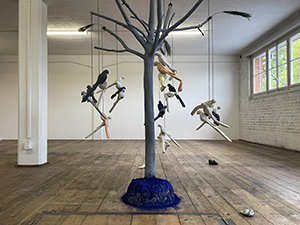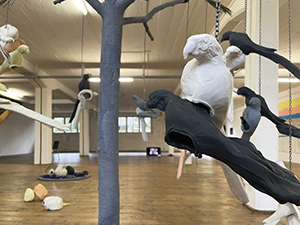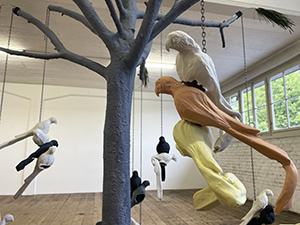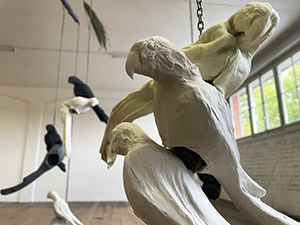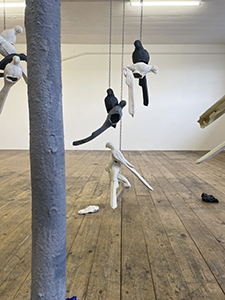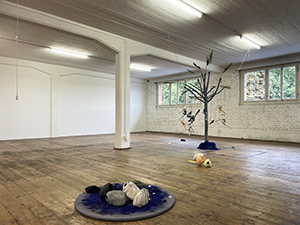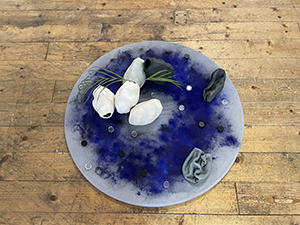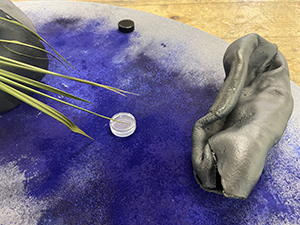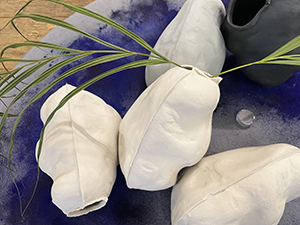
Exotic X: Double charm with a color charge from the periphery II
2022. Pigmented porcelain objects, Bodmer C40 slip cast in matrix made by the artist, platform treated with raw clay slip and ceramic pigments added by the artist to the slip, unglazed, fired at 1230 °C; the tree is a found object, dried, painted with raw stoneware slip of dehydrated clay, smashed, with painting pigments. Dimensions variable.
In this version of the installation, the color of the base of the tree and of the stone assemblage, both made of unfired clay, is accentuated.
Installation and detail views of Exotic X: Double charm with a color charge from the periphery II from the group exhibition Akku Panorama at Zeughaus Uster. Photos courtesy of the artist
Exotic X: Double charm with a color charge from the periphery
Taking center and periphery as a metaphor, the artist twists, doubles and labyrinths a concept that can be used on different scales. As scales are figurative, she builds a model from fragmented objects placed in spatial dimensions with geometry as an organizing principle.
A felled tree occupies the center of the installation; a swarm of cast porcelain fragments constitute the periphery, repeating the same form, coming from the same matrix, the same mold. It emphasizes the unity of the negative and its positive; the form corresponds to its matrix. The entire flock, or set, splits into two disjoint subsets of even and odd elements that have equal status, much like in play, where the stones or pieces are of different color while having the same properties. They can only go a certain distance for the players on the board, and do not overlap, lest one eliminate the other. The qualities of the objects, their charge, their orientation in space, their parity, or the direction of the time flow remain invariant under certain operations in the system of coordinates. The protagonist and antagonist are features of the symmetry, which also reveals the secrets of the exotic matter as pairs annihilate when they meet, with sparking energy from which something unexpected can come into existence.
The flock of parrots deals with negative space and technological reproducibility. The parrots are only the skin without a real body and skeletation. They are empty shells, like the skin shed by a molting snake. They are a simulacra, the charms and simulation in the system, or just the masks of a sorrowful jokester, the tragicomic Pierrot that differs from Pierre, which originally means stone or rock, a cloud of strong artifices. The objects are the outcome of copy and paste, and like in mimetic speech where words lack authenticity, through plasticity they can take poetic detours. In European myths, the parrot is the bird of paradise, the animal that witnessed creation and proves that animals were able to speak. In the same tradition, it also stands for the New World.
For centuries, humans have thought of themselves as the center of the universe. This anthropocentric point of view is blown up by the fact that we live on a small peripheric planet two-thirds of the way out from the center of a galaxy. That center is given by the position of Sagittarius A* as the true zero-coordinate point of the system, a powerful gateway to nothingness. Sagittarius A* is a super-massive black hole at the center of the Milky Way, whose spiral arms revolve around the abyss. The installation brings up the idea of something exotic as an exodus even from the coordinates of Sagittarius A* and its dense place of chaos that swallows entire swarms of star clusters and all matter nearby, not only as a human desire but even, at a quantum level, exotic particles. What can flow backwards under such a powerful force?
The vessel baby is not human but hints at cosmic dust, or fog. As the alchemist says, any whiteness of elements necessarily requires darkening in order to come to existence.
